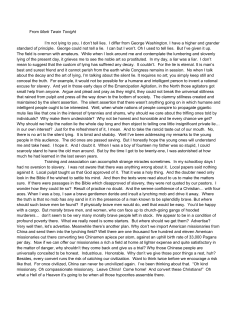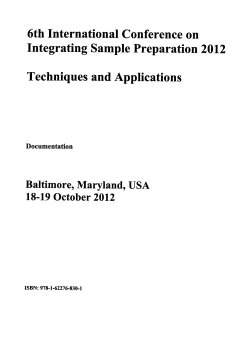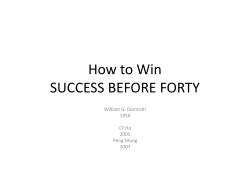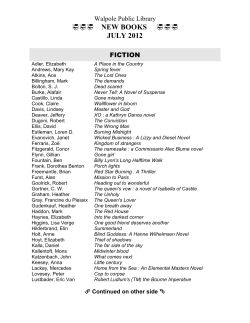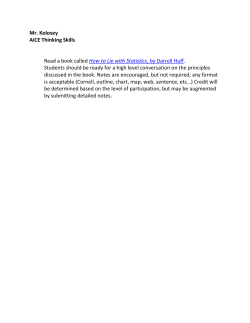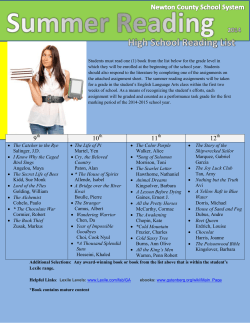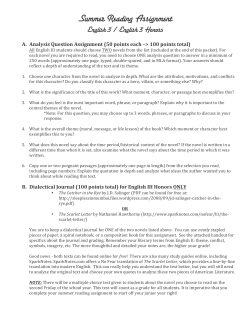
Brave New World Multiple Critical Perspectives Multiple Critical Perspectives
Multiple Critical Perspectives Teaching Aldous Huxley’s Brave New World from Multiple Critical Perspectives by Douglas Grudzina ™ ™ Multiple Critical Perspectives Brave New World General Introduction to the Work Dystopian or Anti-Utopian Novel B rave New World is a dystopian or anti-utopian novel. A dystopian novel is a type of social science fiction typically set in the future (2540 A.D.—or, AF 632, since the new standard for the measurement of time in the novel is based on Henry Ford’s development of mass production for making automobiles). The purpose of the dystopian novel is to satirize current social and geo-political ideas (rampant mate- rialism, a post-WW I desire for “law and order,” and “social stability”) by creating a world that exaggerates the fulfillment of those desires or the eradication of those ills. Hence, the theme of many dystopian novels can be stated: “be careful what you wish for” or “if we stay on this path, here’s where we’ll end up.” Dystopian novels typically involve either a loner or outcast in the society (Bernard), or a newcomer (John Savage) whose inability to conform to the social norms, regardless of how perfect they may seem to the majority of the population (lax sexual mores, rampant drug use, and lack of any desire for real learning and knowledge), forces a confrontation with authorities and ultimately leads to expulsion from society, criminal charges, injury, or death. (John’s inability to conform to the rules of society, as well as his rejection by his community of birth—the Reservation—force him to attempt to lead a new life, only to further his isolation and ultimately bring about his suicide. Bernard finds himself exiled.) The protagonist in the dystopian novel usually causes members of the society at large to question their status quo, sometimes even converting them to his or her way of thinking (John forges a strong friendship with Helmholtz Watson and falls in love with Lenina, both of whom are only slightly able to see the world from John’s point of view), but, most often, dystopian novels do not have a happy ending (John commits suicide, Bernard and Helmholtz are banished from the World State, and the World State remains as it has been with no apparent change). 6 P r e s t w i c k H o u s e , I n c . Brave New World Multiple Critical Perspectives New Historicism Applied to Brave New World Notes on New Historicism A common tendency in the study of literature written in, and/or set in, a past or foreign culture is to assume a direct comparison between the culture as presented in the text and as it really was/is. New Historicism asserts that such a comparison is impossible for two basic reasons. First, the “truth” of a foreign or past culture can never be known as established and unchangeable. At best, any understanding of the “truth” is a matter of interpretation on the parts of both the writer and the reader. This is most blatantly evident in the fact that the “losers” of history hardly ever get heard. The culture that is dominated by another is often lost to history because it is the powerful who have the resources to record that history. Even in recent past events, who really knows both sides of the story? Who really knows the whole of the Nazi story? Or the Iraqi story? New Historicists argue that these unknown histories are just as significant as the histories of the dominant culture of power and should be included in any world view. Since they often contradict “traditional” (i.e., the winner’s) history, there is no way to really know the absolute truth. Second, while the text under consideration does indeed reflect the culture in which it was written (and to some degree in which it is set), it also participates in the culture in which it is written. In other words, its very existence changes the culture it “reflects.” To New Historicists, literature and culture are born of one another. For example, although Harper Lee’s To Kill a Mockingbird certainly reflected the culture of the South during the mid-20th century, it also became a tool to raise awareness of, and change certain elements of, that culture. P r e s t w i c k H o u s e , I n c . 11 Brave New World Multiple Critical Perspectives Activity One Examining the Text for Clues to the Political, Social, and Economic Situation in Europe After World War I 1. Copy and distribute the handout: Brave New World: New Historicism Activity One Timeline. 2.Divide the class into five groups (or a number of groups divisible by five) and assign each (or allow each to choose, so long as all five of the issues are covered) one of the following: • genetic engineering/eugenics • technology • economics • politics/rise of dictators • politics/formation and re-formation of countries 3. Have each group peruse the timeline and note events relevant to its issue. 4.Then have each group peruse the book and note anything (characters, names, facts in exposition, setting details, etc.) that are most likely references to that group’s issue. 5. Have each group report back to the class. 6.As a class, discuss the extent to which Huxley’s World State is a reflection of—or a reaction to—the social, economic, and political climate in which he wrote the book. P r e s t w i c k H o u s e , I n c . 15 Brave New World Multiple Critical Perspectives Psychoanalytic/Freudian Criticism Applied to Brave New World Notes on the Psychoanalytic Theory T he terms “psychological,” or “psychoanalytical,” or “Freudian Theory” seem to encompass essentially two almost contradictory critical theories. The first focuses on the text itself, with no regard to outside influences; the second focuses on the author of the text. According to the first view, reading and interpretation are limited to the work itself. One will understand the work by examining conflicts, characters, dream sequences, and symbols. In this way, the psychoanalytic theory of literature is similar to the Formalist approach. One will further understand that a character’s outward behavior might conflict with inner desires, or might reflect as-yet-undiscovered inner desires. Main areas of study/points of criticism of the first view: P • There are strong Oedipal connotations in this theory: the son’s desire for his mother, the father’s envy of the son and rivalry for the mother’s attention, the daughter’s desire for her father, the mother’s envy of the daughter and rivalry for the father’s attention. Of course, these all operate on a subconscious level to avoid breaking a serious social more. • There is an emphasis on the meaning of dreams. This is because psychoanalytic theory asserts that it is in dreams that a person’s subconscious desires are revealed. What a person cannot express or do because of social rules will be expressed and accomplished in dreams, where there are no social rules. Most of the time, people are not even aware what it is they secretly desire until their subconscious goes unchecked in sleep. r e s t w i c k H o u s e , I n c . 27 Multiple Critical Perspectives Brave New World Activity One Examining the Novel for Evidence of Huxley’s Views on Women and Marriage 1. Divide the class into five groups (or a number of groups divisible by five). 2. Assign each (or allow each to choose) one of the following couples: • Henry Foster and Lenina • Bernard and Lenina • Thomas and Linda • Fanny and Lenina • John and Lenina 3.Have each group peruse the novel for episodes in which its couple interacts or in which one member of the couple talks about the other. 4. Then have students answer the following questions: • What is the accepted relationship between men and women in the novel? • How and why did this social value develop? • Why are long-term relationships and marriage frowned upon? • Where do we find individuals inclined toward celibacy? • Where do we find individuals inclined toward monogamy? • Who are more sympathetic, characters who “fit the norm” of the Brave New World society or those who are “different”? • How does Huxley make these characters more sympathetic? 5.Reconvene the class and discuss whether Huxley seems more to approve of the Brave New World values and morals or the traditional values and morals of his time. 32 P r e s t w i c k H o u s e , I n c . Brave New World Multiple Critical Perspectives Marxist Criticism Applied to Brave New World Notes on the Marxist Approach T he Marxist approach to literature is based on the philosophy of Karl Marx, a German philosopher and economist. His major argument was that whoever controlled the means of production in society controlled the society—whoever owned the factories “owned” the culture. This idea is called “dialectical materialism,” and Marx felt that the history of the world was leading toward a communist society. From his point of view, the means of production (i.e., the basis of power in society) would be placed in the hands of the masses, who actually operated them, not in the hands of those few who owned them. It was a perverted version of this philosophy that was at the heart of the Soviet Union. Marxism was also the rallying cry of the poor and oppressed all over the world. To read a work from a Marxist perspective, one must understand that Marxism asserts that literature is a reflection of culture, and that culture can be affected by literature (Marxists believed literature could instigate revolution). Marxism is linked to Freudian theory by its concentration on the subconscious—Freud dealt with the individual subconscious, while Marx dealt with the political subconscious. Marx believed that oppression exists in the political subconscious of a society—social pecking orders are inherent to any group of people. Four main areas of study: P • economic power • materialism versus spirituality • class conflict • art, literature, and ideologies r e s t w i c k H o u s e , I n c . 35 Brave New World Multiple Critical Perspectives Activity One Examining the Text for Evidence of Commodification 1.Review with the class the introductory notes on commodification and its role in the bourgeoisie’s control of the proletariat. 2. Divide the class into an even number of groups. 3.Assign half of the students to peruse the book and note any scenes that show evidence of materialism or consumerism in the Brave New World society. 4.Assign the other half to peruse the book and note any mention of hypnopaedia messages that encourage materialism or consumerism. Have them include any time adult characters resort to reciting the messages they learned as children. 5. Have each group report back to the class. 6.As a class, discuss how Huxley presents the concept of commodification in his dystopian society and the role commodification plays in the society. P r e s t w i c k H o u s e , I n c . 39
© Copyright 2025


